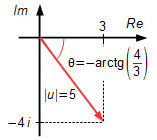Exercício Resolvido de Funções Complexas
publicidade
e) \( \displaystyle (3-4i)^{(1+i)} \)
Usando a expressão
\[ \bbox[#99CCFF,10px]
{u^{v}=\operatorname{e}^{v\;\text{Ln}u}}
\]
\[
\begin{gather}
(3-4i)^{(1+i)}=\operatorname{e}^{(1+i)\;\operatorname{Ln}(3-4i)} \tag{I}
\end{gather}
\]
A função multivalente do logaritmo é dada por
\[
\begin{gather}
\bbox[#99CCFF,10px]
{\operatorname{Ln}z=\ln |z|+i(\operatorname{arg}(z)+2k\pi)} \tag{II}
\end{gather}
\]
O argumento do logaritmo é o número complexo da forma
\[
u=3-4i
\]
O módulo é dado por
\[ \bbox[#99CCFF,10px]
{|z|=\sqrt{x^{2}+y^{2}}}
\]
\[
\begin{gather}
|u|=\sqrt{3^{2}+(-4)^{2}\;}\\
|u|=\sqrt{9+16\;}\\
|u|=\sqrt{25\;}\\
|u|=5 \tag{III}
\end{gather}
\]
O argumento é dado por
\[ \bbox[#99CCFF,10px]
{\theta=\operatorname{arg}(z)=\operatorname{arctg}\left(\frac{y}{x}\right)}
\]
\[
\begin{align}
\theta &=\operatorname{arg}(u)=\operatorname{arctg}\left(\frac{y}{x}\right)=\\
&=\operatorname{arctg}\left(\frac{-4}{3}\right)=-\operatorname{arctg}\left(\frac{4}{3}\right) \tag{IV}
\end{align}
\]

Gráfico 1
substituindo os valores (III) e (IV) na expressão (II)
\[
\begin{gather}
\operatorname{Ln}(3-4i)=\ln\left(5\right)+i\;\left[-\operatorname{arctg}\left(\frac{4}{3}\right)+2k\pi\right] \tag{V}
\end{gather}
\]
substituindo a expressão (V) na expressão (I)
\[
\begin{gather}
(3-4i)^{(1+i)}=\operatorname{e}^{(1+i)\;\left\{\ln\left(5\right)+i\;\left[-\operatorname{arctg}\left(\frac{4}{3}\right)+2k\pi\right]\right\}}\\[5pt]
(3-4i)^{(1+i)}=\operatorname{e}^{\left\{\ln\left(5\right)+i\;\left[-\operatorname{arctg}\left(\frac{4}{3}\right)+2k\pi\right]+i\;\ln\left(5\right)+i.i\;\left[-\operatorname{arctg}\left(\frac{4}{3}\right)+2k\pi\right]\right\}}\\[5pt]
(3-4i)^{(1+i)}=\operatorname{e}^{\left\{\ln\left(5\right)+i\;\left[-\operatorname{arctg}\left(\frac{4}{3}\right)+2k\pi\right]+i\;\ln\left(5\right)+i^{2}\;\left[-\operatorname{arctg}\left(\frac{4}{3}\right)+2k\pi\right]\right\}}\\[5pt]
(3-4i)^{(1+i)}=\operatorname{e}^{\left\{\ln\left(5\right)+i\;\left[-\operatorname{arctg}\left(\frac{4}{3}\right)+2k\pi\right]+i\;\ln\left(5\right)+(-1)\;\left[-\operatorname{arctg}\left(\frac{4}{3}\right)+2k\pi\right]\right\}}\\[5pt]
(3-4i)^{(1+i)}=\operatorname{e}^{\left\{\ln\left(5\right)+i\;\left[-\operatorname{arctg}\left(\frac{4}{3}\right)+2k\pi\right]+i\;\ln\left(5\right)-\;\left[-\operatorname{arctg}\left(\frac{4}{3}\right)+2k\pi\right]\right\}}\\[5pt]
(3-4i)^{(1+i)}=\operatorname{e}^{\left\{\left[\ln\left(5\right)+\operatorname{arctg}\left(\frac{4}{3}\right)-2k\pi\right]+i\;\left[\ln\left(5\right)-\operatorname{arctg}\left(\frac{4}{3}\right)+2k\pi\right]\right\}}
\end{gather}
\]
\[
\begin{gathered}
\qquad \qquad \quad (3-4i)^{(1+i)}=\operatorname{e}^{\left\{\left[\ln\left(5\right)+\operatorname{arctg}\left(\frac{4}{3}\right)+2k\pi\right]+i\;\left[\ln\left(5\right)-\operatorname{arctg}\left(\frac{4}{3}\right)+2k\pi\right]\right\}}\quad ,\quad k\in \mathbb{Z}
\end{gathered}
\]
\[
\begin{gather}
(3-4i)^{(1+i)}=\operatorname{e}^{\left\{\left[\ln\left(5\right)+\operatorname{arctg}\left(\frac{4}{3}\right)-2k\pi\right]+i\;\left[\ln\left(5\right)-\operatorname{arctg}\left(\frac{4}{3}\right)+2k\pi\right]\right\}}\\[5pt]
(3-4i)^{(1+i)}=\operatorname{e}^{\ln\left(5\right)}.\operatorname{e}^{\operatorname{arctg}\left(\frac{4}{3}\right)-2k\pi}.\operatorname{e}^{i\;\left[\ln\left(5\right)-\operatorname{arctg}\left(\frac{4}{3}\right)+2k\pi\right]}\\[5pt]
(3-4i)^{(1+i)}=5\operatorname{e}^{\operatorname{arctg}\left(\frac{4}{3}\right)-2k\pi}.\operatorname{e}^{i\;\left[\ln\left(5\right)-\operatorname{arctg}\left(\frac{4}{3}\right)+2k\pi\right]}
\end{gather}
\]
Aplicando a Fórmula de Euler
\[ \bbox[#99CCFF,10px]
{\operatorname{e}^{i\theta}=\cos \theta +i\operatorname{sen}\theta}
\]
\[ \bbox[#FFCCCC,10px]
{(3-4i)^{(1+i)}=5\operatorname{e}^{\operatorname{arctg}\left(\frac{4}{3}\right)-2k\pi}\left\{\cos \left[\ln\left(5\right)-\operatorname{arctg}\left(\frac{4}{3}\right)\right]+i\operatorname{sen}\left[\ln\left(5\right)-\operatorname{arctg}\left(\frac{4}{3}\right)\right]\right\}}
\]
publicidade

Fisicaexe - Exercícios Resolvidos de Física de Elcio Brandani Mondadori está licenciado com uma Licença Creative Commons - Atribuição-NãoComercial-Compartilha Igual 4.0 Internacional .